by Tim Brennan and Rick Landers
Introduction
by Rick Landers
Standing six-feet four, with wavy black hair and movie star looks, guitar designer and builder Semie Moseley left his mark on guitar history with his creation of the Mosrite Ventures model. And it truly was an act of creation. Every aspect of these instruments reflects Moseley’s hand – he designed the pickups, wound them himself, designed the cool “M” headstock, added the German carve, tilted the neck pickup, introduced “speed frets” – and then lavished his creations with exquisite paint jobs we waded in until the surf was up.
Today, collectors pay thousands for the 1960s Ventures models. Moseley’s guitar building legacy will remain with us forever as we listen to Mosrites played by the Ventures, the Ramones, Kurt Cobain, Merle Haggard and Buck Owens. Mosrites stand at the head of the line among its guitar relatives: Standel, Hallmark, Gruggett, Stradette, and others nurtured by the California electric guitar pioneers.
Tim Brennan, owner of Tym’s Guitars in Brisbane, Australia, is one of the world’s top Mosrite guitar experts. His three part “Mosrite Story” provides Guitar International readers an insightful look at Semie Moseley and the adventurous starts and stops of the Mosrite guitar company.
The Mosrite Story
by Tim Brennan
Part One: From the beginning through the Ventures
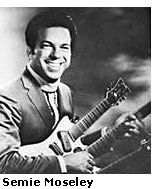 The Mosrite company was started in 1952 by Semie Moseley with the financial help of a friend, Rev. Ray Boatwright, who bought Semie his first band saw in the early ’50s. Semie had been obsessed by guitars as a teenager and started repairing, and later building them, because he could not find one that felt or sounded quite right.
The Mosrite company was started in 1952 by Semie Moseley with the financial help of a friend, Rev. Ray Boatwright, who bought Semie his first band saw in the early ’50s. Semie had been obsessed by guitars as a teenager and started repairing, and later building them, because he could not find one that felt or sounded quite right.
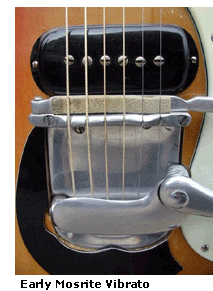 By the time he was 19-years-old, Semie had not only built his first triple-neck guitar, he was repairing guitars for local artists like Merle Travis. These early guitars were almost completely handmade by Semie from 1952 to ’58/’59, using primitive hand-tools and carving the aluminum vibratos by hand. He also went through the time consuming process of forming the pickup covers over a mold in his oven and winding the bobbins by hand.
By the time he was 19-years-old, Semie had not only built his first triple-neck guitar, he was repairing guitars for local artists like Merle Travis. These early guitars were almost completely handmade by Semie from 1952 to ’58/’59, using primitive hand-tools and carving the aluminum vibratos by hand. He also went through the time consuming process of forming the pickup covers over a mold in his oven and winding the bobbins by hand.
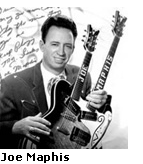 Early models he built included a double-neck for Joe “King of the Strings” Maphis. “It was a beautiful instrument” said Gene Moles, an assembly line inspector for Mosrite guitars, a session musician from Bakersfield, and a member of Jimmy Thompson’s TV band. This double-neck was one of the slightly bulkier designs, also used by Larry Collins whose double neck was finished in 1956, unlike the smoother double-necks made a little later in the 1950s for people like Brian Lonbeck.
Early models he built included a double-neck for Joe “King of the Strings” Maphis. “It was a beautiful instrument” said Gene Moles, an assembly line inspector for Mosrite guitars, a session musician from Bakersfield, and a member of Jimmy Thompson’s TV band. This double-neck was one of the slightly bulkier designs, also used by Larry Collins whose double neck was finished in 1956, unlike the smoother double-necks made a little later in the 1950s for people like Brian Lonbeck.
At first, it was all custom, handmade guitars, built wherever the Moseleys could put equipment – in garages or storage sheds. Semie even set up shop in a friend’s barn outside of Los Angeles, rent free. This infamous “tin shed” in Oildale, California, is still standing and is about the size of a two car garage.
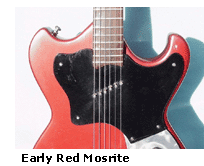 The first Mosrite Ventures model prototypes were built here, as were several double-necks and more standard “Tele”-shaped single-necks, still with mainly hand-made parts as in the beginning Semie did everything himself. He would later move to a cement block building on Kern Street in Oildale and then to Bakersfield, California. The Bakersfield location would give rise to his association with the now famous honky tonk, “Bakersfield Sound”, known for its country western twangers.
The first Mosrite Ventures model prototypes were built here, as were several double-necks and more standard “Tele”-shaped single-necks, still with mainly hand-made parts as in the beginning Semie did everything himself. He would later move to a cement block building on Kern Street in Oildale and then to Bakersfield, California. The Bakersfield location would give rise to his association with the now famous honky tonk, “Bakersfield Sound”, known for its country western twangers.
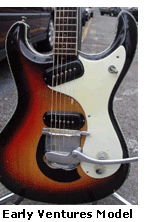 These were challenging times for Semie. In the winter is was bitterly cold and he would burn wood cuts and shavings from guitar remnants in a 44-gallon drum to keep warm. He had no money and wanted to start a guitar manufacturing company but could not get financed.
These were challenging times for Semie. In the winter is was bitterly cold and he would burn wood cuts and shavings from guitar remnants in a 44-gallon drum to keep warm. He had no money and wanted to start a guitar manufacturing company but could not get financed.
This is one of the Ventures prototypes from the late ’50s with bound body and set neck. As you can see, the guitar is close to the final early “production” model, but with a few small exceptions. The symmetrical headstock says “Joe Maphis model by Mosrite of California” as the Ventures deal hadn’t been worked out yet. This guitar also has what was to become known as the “mistake plate” around the vibrato. Semie had set the neck too shallow and needed to recess the unit into the body, necessitating a plate to hide the mistake.
Enter the Ventures
Semie had built a guitar that he lent to Nokie Edwards of the Ventures to use on some recording sessions. This was to change everything! Nokie bought a guitar from Semie and, within a year, an endorsement deal with the Ventures would make Mosrite a household name, at least in the surf/instrumental guitar world.
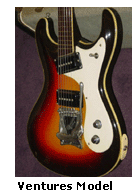 It was probably Nokie who made the Mosrite name famous. Nokie was the lead guitarist for the Ventures, an instrumental group, and by 1962 the entire band was playing Mosrites on songs like “Walk Don’t Run” and the theme from “Hawaii 5-O”. The back of one of their albums read, “Guitars courtesy of Mosrite Distributing Corporation”. That was enough to start the ball rolling and soon Mosrite had substantial orders from dealers, which signaled the start of Mosrite’s heyday. Initially building 20-30 guitars a month, the orders kept coming in and Mosrite was on its way to becoming a credible American guitar manufacturer.
It was probably Nokie who made the Mosrite name famous. Nokie was the lead guitarist for the Ventures, an instrumental group, and by 1962 the entire band was playing Mosrites on songs like “Walk Don’t Run” and the theme from “Hawaii 5-O”. The back of one of their albums read, “Guitars courtesy of Mosrite Distributing Corporation”. That was enough to start the ball rolling and soon Mosrite had substantial orders from dealers, which signaled the start of Mosrite’s heyday. Initially building 20-30 guitars a month, the orders kept coming in and Mosrite was on its way to becoming a credible American guitar manufacturer.
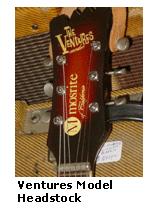 At the peak of production in 1968, Semie, his brother Andy and their crew of 107 employees, were making about 600 guitars a month – acoustics, standard electrics, double-necks, triple-necks, and basses. They were also producing effects pedals, amplifiers, Dobros (which Mosrite bought in 1966), and Melobar slide guitars, which Semie was making for the Melobar company. The most popular Mosrites were the Ventures models and today, when guitarists talk about Mosrites, they are usually referring to the models shown on Ventures’ albums.
At the peak of production in 1968, Semie, his brother Andy and their crew of 107 employees, were making about 600 guitars a month – acoustics, standard electrics, double-necks, triple-necks, and basses. They were also producing effects pedals, amplifiers, Dobros (which Mosrite bought in 1966), and Melobar slide guitars, which Semie was making for the Melobar company. The most popular Mosrites were the Ventures models and today, when guitarists talk about Mosrites, they are usually referring to the models shown on Ventures’ albums.
The Mosrite Ventures Model
Semie had been working with Bob Crooks of the Standel guitar company who wanted Semie to design a guitar for him “like a Fender”. This guitar eventually became the basis for the Mosrite Ventures model. Early examples of these guitars have “Joe Maphis Model”, or, simply, “Mosrite” on the headstock.
Legend has it that Semie flipped over a Stratocaster and traced around it to produce the now-classic Mosrite body design. However, the shape of the Mosrite Ventures model is more elaborate, more curvaceous, and, in the opinion of many, more pleasing to the eye than an upside down Strat. In fact, Semie’s innate talent for original guitar design would prove itself again and again over the years.
After working on a prototype with guitar artisan Bill Gruggett, the first “official Ventures” guitar became available in 1963. The first model had a set neck and a celluloid-bound body, with a large “The Ventures” logo on the headstock. They were available in red or sunburst only. The amplifier jack was on the side of the guitar and these are referred to as the “side jack models”.

The necks were very thin and had extremely low frets known at Mosrite as “speed frets”. They had a zero fret and semi-circular-type metal string guide (nut). The vibrato unit on these early models was called a “Vibramute” and had a special muting mechanism near the bridge. All Mosrite production numbers are sketchy, but it’s believed approximately 200 of these guitars were built. The Ventures used this model on their January, 1965, tour.
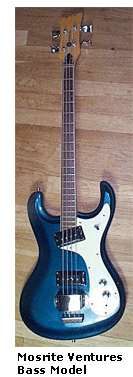 In 1964, the amplifier jack was moved on to the pickguard and the body binding was dropped. The neck joint was changed to the bolt-on type but the screw heads were covered by a metal plate, which was subsequently changed to a more standard type bolt-on neckplate with exposed screw heads.
In 1964, the amplifier jack was moved on to the pickguard and the body binding was dropped. The neck joint was changed to the bolt-on type but the screw heads were covered by a metal plate, which was subsequently changed to a more standard type bolt-on neckplate with exposed screw heads.
All of these changes suggest economy in manufacturing as the “original” design would have been very expensive to produce. The Ventures logo became smaller in mid ’64 and the pickups changed to show the “Mosrite of California” logo embossed on them, but with no “R” for registered trade mark.
In the next installment of the Mosrite Story, we’ll take a close look at the company during the 1960s and ’70s – and have more to say about the Mosrite Ventures models.
Related articles
The Story of Mosrite Guitars, Part Two
The Story of Mosrite Guitars, Part Three
Contact Information
Company: Tym’s Guitars
Contact: Tim Brennan
Address and hours: 33 Fern Street, Buranda, QLD, Australia. 4102 Tues.-Fri., 9am-6pm
Telephone: +1 61 7 3891 2185 (Australia)
Website: www.tymguitars.com.au